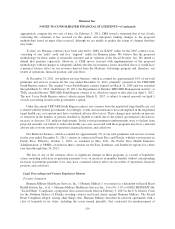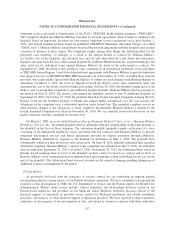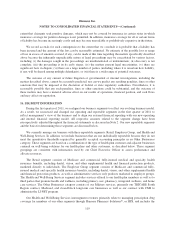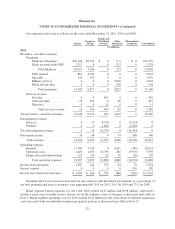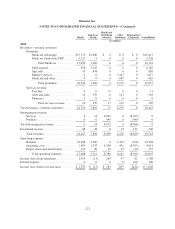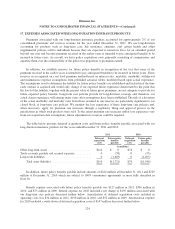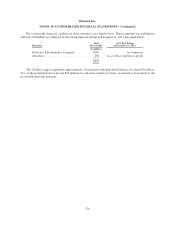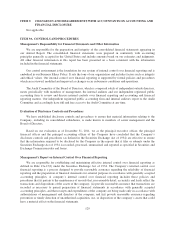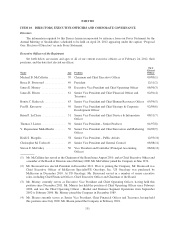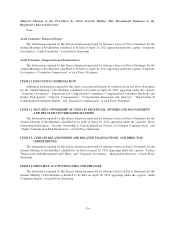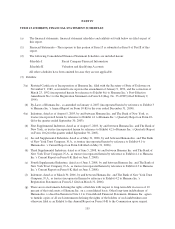Humana 2011 Annual Report Download - page 135
Download and view the complete annual report
Please find page 135 of the 2011 Humana annual report below. You can navigate through the pages in the report by either clicking on the pages listed below, or by using the keyword search tool below to find specific information within the annual report.Humana Inc.
NOTES TO CONSOLIDATED FINANCIAL STATEMENTS—(Continued)
Future policy benefits payable include $938 million at December 31, 2011 and $825 million at
December 31, 2010 associated with a closed block of long-term care policies acquired in connection with the
November 30, 2007 acquisition of KMG . During the fourth quarter of 2010, certain states approved premium
rate increases for a large portion of our long-term care block that were significantly below our acquisition date
assumptions. Based on these actions by the states, combined with lower interest rates and higher actual expenses
as compared to acquisition date assumptions, we determined that our existing future policy benefits payable,
together with the present value of future gross premiums, associated with our long-term care policies were not
adequate to provide for future policy benefits under these policies; therefore we unlocked and modified our
assumptions based on current expectations. Accordingly, during the fourth quarter of 2010 we recorded
$139 million of additional benefit expense, with a corresponding increase in future policy benefits payable of
$170 million partially offset by a related reinsurance recoverable of $31 million included in other long-term
assets.
Deferred acquisition costs included $54 million and $36 million associated with our individual commercial
medical policies at December 31, 2011 and December 31, 2010, respectively. Future policy benefits payable
associated with our individual commercial medical policies were $233 million at December 31, 2011 and $180
million at December 31, 2010. In light of the Health Insurance Reform Legislation, including mandating that
80% of premiums revenue be expended on medical costs for individual commercial medical policies beginning
in 2011, we completed a deferred acquisition cost recoverability analysis for our individual commercial medical
policies during 2010. Our recoverability test indicated that a substantial portion of unamortized deferred
acquisition costs associated with the individual commercial medical block of business were not recoverable from
future income. As a result, during 2010 we recorded a write-down of deferred acquisition costs of $147 million
with a corresponding charge to operating costs.
18. REINSURANCE
Certain blocks of insurance assumed in acquisitions, primarily life, long-term care, and annuities in run-off
status, are subject to reinsurance where some or all of the underwriting risk related to these policies has been
ceded to a third party. In addition, a large portion of our reinsurance takes the form of 100% coinsurance
agreements where, in addition to all of the underwriting risk, all administrative responsibilities, including
premium collections and claim payment, have also been ceded to a third party. We acquired these policies and
related reinsurance agreements with the purchase of stock of companies in which the policies were originally
written. We acquired these companies for business reasons unrelated to these particular policies, including the
companies’ other products and licenses necessary to fulfill strategic plans.
A reinsurance agreement between two entities transfers the underwriting risk of policyholder liabilities to a
reinsurer while the primary insurer retains the contractual relationship with the ultimate insured. As such, these
reinsurance agreements do not completely relieve us of our potential liability to the ultimate insured. However,
given the transfer of underwriting risk, our potential liability is limited to the credit exposure which exists should
the reinsurer be unable to meet its obligations assumed under these reinsurance agreements.
Reinsurance recoverables represent the portion of future policy benefits payable that are covered by
reinsurance. Amounts recoverable from reinsurers are estimated in a manner consistent with the methods used to
determine future policy benefits payable as detailed in Note 2. Reinsurance recoverables, included in other
long-term assets, were $436 million at December 31, 2011 and $421 million at December 31, 2010. The
percentage of these reinsurance recoverables resulting from 100% coinsurance agreements was approximately
51% at December 31, 2011 and approximately 54% at December 31, 2010. Premiums ceded were $34 million in
2011, $34 million in 2010 and $33 million in 2009.
125



